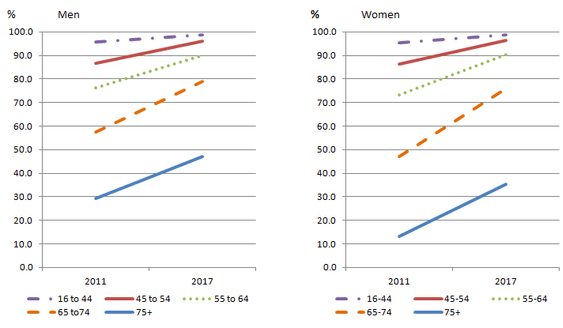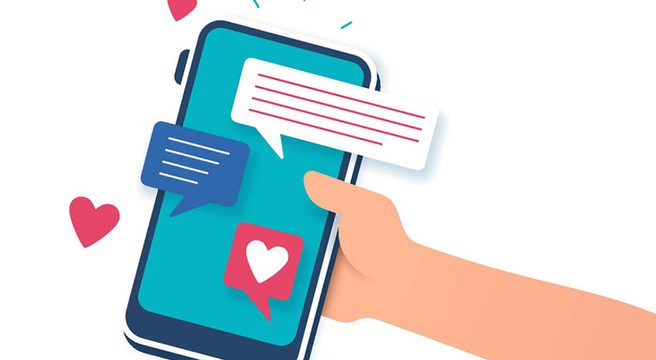In September 2017 it was announced that after 50 years in production, the final print run of Yellow Pages will start in January 2018, with the final ever edition distributed to the Brighton area in January 2019. It’s most certainly the end of an era, but it’s fantastic to see the Yell business completely embrace digital. But what can other businesses learn from this leap that Yell has made?

Source: Office for National Statistics
When you look at statistics for online usage:
- UK online retail sales reached £133bn in 2016, an increase of 15.9% from 2015
- In Jan to Mar 2017, 89% of adults in the UK had recently used the internet (in the last 3 months) – increased from 2016
- People are spending twice as much time online compared to 10 years ago
Every statistic you see suggests the trend that more people in the UK are going online each year, they are spending more time while they are there, and they are researching and buying more online. This shift has been across every age group.
[bctt tweet=”People spend twice as much time online than 10 years ago, your business needs to be online too”]
The point being that there are now an awful lot of people online and using the internet regularly. From a marketing perspective, you should always go where your audience is, and for most businesses, that audience is now online. So as a business you need to think digitally and how you are going to access your online audience.
Small and/or local businesses tend to be the most reluctant to get online. So I’ll focus on them in this article.
Reluctant About Digital

Now, I know that not everyone is not keen to jump into digital, there are multiple reasons why business owners might feel this way:
- They don’t have any digital knowledge
- They have done OK without it up to now
- Their competitors/industry aren’t embracing digital
- They are worried about the expense and time to maintain it
- They don’t think the audience is online
There is a brilliant infographic outlining reasons why small businesses don’t have their own websites – I’ve put a small excerpt of the image here but you can click the image to see the full version. (P.S. The infographic is American, but the facts and figures are almost identical to the UK – so still very relevant!)
The thing is, that no matter what any of us think, the stats will always tell us the truth. They are telling us that people are online and that they want businesses to be online too.
What Do Customers Want?
In this great article from Score, they look at What Do Customers Want from Local Businesses? and spoke to 6000 consumers nationwide. The consumers told them what they would like from local businesses, which is:
- Online reviews: 76 percent want to see online reviews for local businesses. Customers like to see other peoples opinions before they buy, to make sure they are going to get a good service or product. Not only are reviews helpful to customers, but they also help improve your SEO.
- Easy-to-use websites: Something simple and user-friendly. Even if it has the most basic of information on such as location, opening times and phone number.
For example, this weekend I wanted some Fish & Chips from a local shop. I looked everywhere online to find the opening times, but I couldn’t, not even on the Facebook page. So I ended up going down there and it was closed. It didn’t even have the opening times on the door. Now, not only did the business owners lose my order this time, they will lose future orders as: 1) I still don’t know the opening times, 2) I’m not going to risk going again when I can’t check online to see if the shop is open before I go, 3) I’ve moaned about the issues loads of people locally so it’ll probably put them off going too! - Self-service: More than quarter of respondents want to book appointments, manage billing and make payments online.
- More frequent online communications: Sending emails and online messages to customers is a great way to remind them you are there, and to entice them back with some news, an event or an offer. Consumers want to get the following communications from local businesses:
- Service/appointment reminders (84 percent)
- Advice/helpful tips (80 percent)
- Business/service updates (76 percent)
- Survey requests for feedback (67 percent)
- Personalised communications (65 percent)
- Invitations to events (63 percent)
- Newsletters (60 percent)
It’s Easier Than You Think
 When learning something new, it can seem daunting. But the great thing about getting your business online is that there is so much help around!
When learning something new, it can seem daunting. But the great thing about getting your business online is that there is so much help around!
Some places you can look for help:
- The Yell Knowledge Centre that this post is part of has loads of useful tips for getting your business online.
- YouTube: you can search for topics like “small business website” to find lots of ideas.
- Online courses from sites like Udemy where you can learn about digital and online marketing.
- Barclays Digital Eagles: They have online courses and tips for setting up your business online
The one thing I’d say though, is you really do need a website. A website doesn’t have to be expensive, you can use services like Yell Website Design to have a site built that doesn’t break the bank. It’s important to use a service that creates mobile friendly websites as 66% of people use their mobile phone to access the internet.
The next best thing is a strong social media page, depending on your business type then Facebook, Twitter, or LinkedIn might suit you best. It will at least give you an online presence that will then bring you up in the search results when people search for your business. These are free to create and fairly simple. If you need instructions, there are always handy videos and tutorials – just search in Google for “setting up a business Facebook page” or something along those lines.
So, go and be inspired by Yell’s leap into a complete digital world. Take your business online and connect with a huge portion of your audience that you may have been missing out on. Go where the audience is and entice them to be customers through their computers and smartphones!





